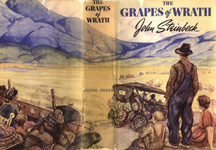A Special Collections Research Center Exhibition
4 February
- 27 May, 2005
E.S. Bird Library, 6th floor
Viewing Hours: Monday - Friday, 9 a.m. to 5 p.m.
In support of the "If All of Central New York Reads" initiative and the Syracuse Stage production of The Grapes of Wrath, the Special Collections Research Center will display some of its radicalism holdings in literature and art. Along with contemporary critical responses to publication of John Steinbeck's The Grapes of Wrath, the exhibit will include other, if less well-known, Depression Era novels by Robert Cantwell, Edward Dahlberg, and Grace Lumpkin; an assortment of 1930s cartoons by A. Redfield and Otto Soglow; and a backward look at the uses of art, particularly drama, in the service of revolutionary ideology.
| Notes on Steinbeck's The Grapes of Wrath from the Granville Hicks Papers. Hicks (1901-82) was the literary editor for New Masses, the New Leader, and the Saturday Review of Literature. |
"I feel this book may just possibly do for our time what Les Miserables did for its, Uncle Tom's Cabin for its, The Jungle for its. The Grapes of Wrath is the kind of art that's poured out of a crucible in which are mingled pity and indignation." Clifton Fadiman, "Books," New Yorker 15 [15 April 1939], 81-83).
It is, from any point of view, Steinbeck's best novel, but it does not make one wonder whether, on the basis of it, Steinbeck is now a better novelist than Hemingway or Farrell or Dos Passos; it does not invoke comparisons; it simply makes one feel that Steinbeck is, in some way all his own, a force."(Louis Kronenberger, "Hungry Caravan," Nation 148 [15 April 1939], 440-41).
"Between chapters Author Steinbeck speaks directly to the reader in panoramic essays on the social significance of the Okie's story. Burning tracts in themselves, they are not a successful fiction experiment. In them a 'social awareness' outruns artistic skill" ("Okies," Time 33 [17 April 1939], 87).
"Mr. Steinbeck has invention, observation, a certain color of style which for some reason does not possess what is called magic" (Edmund Wilson, "The Californians: Storm and Steinbeck," New Republic 103 [9 December 1940], 784-87).
"I dislike his manner of writing, which I think epitomises the intolerable sentimentality of American "realism." I think he wrecks a beautiful dialect with false cadences; I think he is frequently uncertain about where to end a sentence; I think his repetitiveness is not justified by emotional result; and whereas the funny, niggling coarseness which he jovially imposes on his pathetic migrants may be true to type, it seemed to me out of tone, and to offend against the general conception" (Kate O'Brien, "Fiction," Spectator 163 [15 September 1939], 386).
|
Upton Sinclair (1878-1968) was a novelist and one of the original "muckrakers." Publication of The Jungle in 1906 marked one of the earliest appearances of the radical novel in the United States. "Steinbeck is a poet. He loves the country, he loves the people, he loves everything that he describes. He will sit down and watch a land turtle crawling up a dusty bank and he knows every move of the turtle's head and feet; he tells it with such a fine humor that he makes the turtle human - as to some extent all living creatures are. He does the same job for a roadside fillingstation or an 'eats' joint, for a dog hit by an automobile, for an old woman going out of her mind from exhaustion. Everything is real, everything perfect. At least everything suits me; I wouldn't know how to make it better |
"I have come to the age where I know I won't be writing forever. I remember reading how Elijah put his mantle on the shoulders of Elisha. John Steinbeck can have my old mantle if he has any use for it" (Upton Sinclair, Common Sense 8, no. 5 [May 1939], 23).
"That summer I did little public speaking, although I did go to Cambridge to talk about Steinbeck's Grapes of Wrath for the benefit of a left-wing bookstore" (Granville Hicks, Part of the Truth [New York: Harcourt, Brace, and World, 1965], 175).








